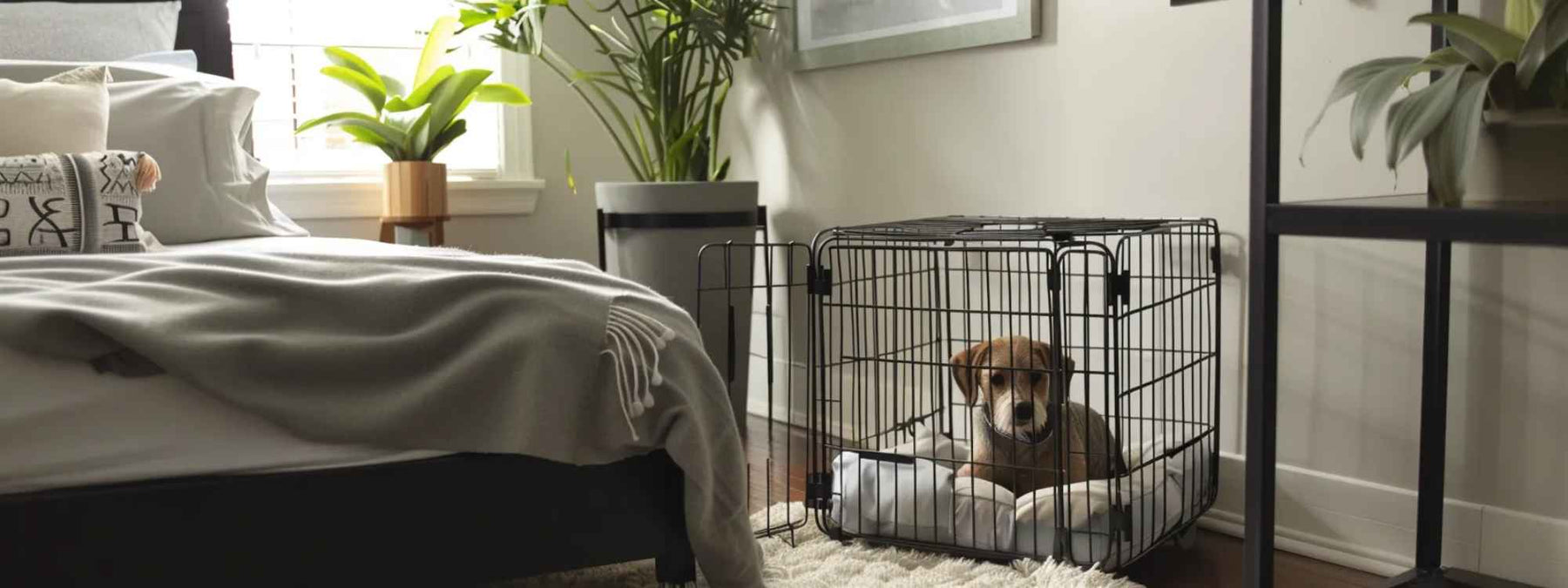737-215-3211

Is It Cruel to Crate a Dog at Night?
You've just brought home a puppy. It's adorable, curious, and currently chewing through your favorite sneakers. Now bedtime hits, and you wonder—should you really lock your pup in a crate overnight?
It feels a bit harsh. And honestly, you're not alone.
Crate training is one of those controversial dog topics. Ask ten different people, and you'll probably get ten different answers. Some swear dog crates offer comfort and security, while others argue it's unfair or even cruel.
So, what's the deal?
Let's figure out if crate training your dog at night is helpful or harmful.
What Does Dog Crate Training Do for Your Puppy at Night?
A dog crate is simply an enclosed space—usually a wire cage or cozy kennel—that your dog can sleep in. Think of it as your dog’s private bedroom. It’s not meant to punish or isolate. Instead, dog crates create a secure, comfortable environment where your pup can relax without supervision.

Dog experts and trainers often recommend nighttime crating for a few smart reasons:
- House training: Dogs naturally avoid messing up their sleeping area. Crates reinforce good bathroom habits by encouraging your pup to wait until morning to do their business.
- Safety first: Puppies and curious dogs can easily get into trouble at night. Crating protects them from household hazards—like electrical cords or small objects they shouldn’t chew.
- Preventing damage: Puppies love to chew (your furniture probably knows this well). A YML G Series Collapsible Metal Pet Crate helps avoid late-night destruction, saving both your stuff and your sanity.
Veterinarians also support thoughtful crate use.
But there’s a catch. Crates shouldn’t be used excessively. Too much crate time can lead to stress, anxiety, or loneliness.
Crating at night, done right, offers your dog safety and comfort. But balance and common sense are key.
Could Crating Hurt Your Dog?
If the thought of crating your dog overnight leaves you feeling a bit uneasy, you're definitely not the only one. There's a reason you're asking this question. No one wants to accidentally harm their pet—emotionally or physically.
The truth is, crating can become problematic if it's misused. The New Age Pet InnPlace Dog Crate isn't meant for your dog to spend endless hours alone. Dogs need companionship, exercise, and regular bathroom breaks. Ignoring these basic needs turns crating from a helpful routine into an unfair practice.
So, when does crating cross the line?
It comes down to two things: how long your dog stays in the crate and whether its essential needs are met.

If your dog spends most of its day and night locked inside, that's excessive. And skipping bathroom breaks or withholding water? That's neglect, plain and simple.
Signs crating could be affecting your dog negatively:
- Constant whining, barking, or scratching at the crate door
- Visible anxiety or stress (panting, pacing, drooling)
- Refusal to enter the crate voluntarily
- Withdrawal, lethargy, or loss of interest in usual activities
- Physical issues like sores from prolonged confinement
The difference between a tool and a punishment:
The dog crate itself isn't the issue—it's how you use it.
Think about it like this: a dog crate used thoughtfully provides comfort and safety. But when used excessively or as punishment, it quickly loses its positive purpose and creates distress instead.
In other words, intention matters. Keep crate time reasonable and supportive, not isolating or punitive.
How Long Can You Safely Crate Your Dog Overnight?
There’s no one-size-fits-all rule here. But there are some solid guidelines to help you avoid overdoing it.
Let’s start with puppies. They have small bladders, lots of energy, and a limited attention span. That means they shouldn't be crated more than 3 to 4 hours at a time when they're young—even at night. You’ll likely need to get up once or twice for bathroom breaks.
As dogs get older, they can hold it longer. Most adult dogs can sleep through the night without a problem—around 7 to 8 hours in a crate is typically fine. Just make sure they’ve had enough exercise and a chance to go to the bathroom before bed.
Dog breed also plays a role. High-energy dogs or working breeds might need more stimulation and exercise before settling in. Older dogs may need extra bathroom trips, even if they’ve been crate trained for years.
The key? Stay flexible. As your dog grows or their needs change, so should your routine. A puppy’s crate schedule won’t work forever, and it’s not meant to.
Watch your dog’s behavior, adjust as needed, and always put their comfort first.
3 Big Myths About Crating Dogs at Night—Let's Clear Things Up
Crate training gets a lot of mixed reviews. Some swear by it. Others avoid it like the plague. A big part of the confusion? Myths that just won’t go away.
Let’s break down a few of the most common ones—and get to the truth.
Myth #1: "Crating is Always Cruel"
The idea of locking a dog in a box sounds harsh at first. But here’s the reality: when used the right way, a crate can be a safe, calm space. Kind of like a bedroom, not a prison cell.
Dogs are den animals by nature. Many feel more secure in smaller, enclosed spaces—especially at night. That’s why some actually choose to sleep in their Lucky Dog Dwell Series Wire Crate with Sliding Side Door, even when the door is left open.

What matters is how long they’re crated, and how it’s introduced. Cruelty only comes in when it’s used too much or as punishment.
Myth #2: "Dogs Naturally Hate Their Crates"
Some dogs do push back at first. But that’s usually because the dog crate is new—or was introduced too fast.
With the right training, most dogs learn to see their Zinger Airline Approved Aluminum Cage as a good thing. A comfy spot. A quiet retreat.
Things like cozy bedding, familiar dog toys, and calm reinforcement help create that positive connection. Rushing the process? Not so helpful.
Myth #3: "Crating Will Solve Behavioral Issues Automatically"
Crates are helpful—but they’re not magic.
They can support house training. And they can prevent your dog from chewing your couch while you sleep. But they don’t fix behavior issues on their own.
Think of crating as one part of a bigger plan. Training, exercise, consistency, and attention are just as important. Maybe even more.
Simple Steps to Make Sure Your Dog Loves Their Crate
Introducing your dog to their Bowsers Moderno Double Door Wooden Dog Crate doesn't need to be complicated. A few simple steps can make the whole experience smoother for both of you.

Here's exactly how to get started:
- Start slow. Don't just shut the door and hope for the best. First, leave the door open and let your dog explore. Toss a treat inside to encourage curiosity. Keep sessions short at first—a couple of minutes is plenty.
- Make it a nice place to be. Comfort matters. Put down soft bedding your dog loves. Add in a favorite toy or chew. Position the crate somewhere peaceful but not isolated, so your dog still feels part of things.
- Reward good moments. Every time your dog willingly goes into the crate, give positive reinforcement. A quick "good job" and a small treat go a long way.
- Build up time slowly. Once your dog seems comfortable, gently close the door—but only for a few minutes at first. Gradually increase the amount of time. Always keep it positive. If they start fussing, calmly wait until they're quiet again before opening the door.
- Consistency wins. Dogs love routines. Crate your dog at roughly the same time every night. This creates predictability, helping your dog settle easily.
How Do You Know If Your Dog Is Happy in Their Crate?
Once your dog gets used to the YML DSA Series Heavy Duty Dog Crate, you’ll start seeing a few clear signs that they actually like it. No guesswork needed.
Here’s what to look for:
- They walk in on their own. If your dog heads into the crate without being asked, that’s a good sign. It means they see it as a safe spot—not a trap.
- They settle in quickly. No pacing, whining, or scratching. Just a calm, relaxed posture. Maybe even a slow blink or a big sigh. That’s the body language of a dog who’s content.
- They sleep soundly. A dog that snoozes through the night in their crate is comfortable being there. If they curl up and drift off, the crate is doing its job.
But if your dog avoids the crate, cries non-stop, or seems overly stressed—pause and reassess. Go back a few steps. Make the crate more inviting. Try shorter crate sessions and more rewards. If the stress continues, it might be worth checking in with a vet or trainer. Sometimes, a small tweak makes a big difference.
What to Do if Your Dog Really Hates Being Crated?
Not every dog takes to a crate. And that’s okay.
If you’ve tried easing them in, made it cozy, and they’re still clearly stressed—don’t force it. Some dogs just don’t like crates, no matter how well you introduce them.

Here’s what you can do:
- Talk to a vet or trainer. They can help rule out anxiety issues or suggest better training techniques.
- Try other options. A dog-proofed room, a gated-off area, or a sturdy playpen might work better. These still create boundaries, just with a little more space.
- Stay flexible. The goal isn’t to tick a box—it’s to help your dog feel safe at night. If the crate isn’t working, it’s not a failure. It just means a different setup might suit your dog better.
Finding the Right Balance: Your Dog’s Needs Matter
You’re reading this because you care—and that matters.
Every dog is different. What works for one might not work for another. Some dogs love their New Age Pet Homestead Crate. Others, not so much. And that’s okay.
Crating isn’t about being strict or getting it perfect. It’s about keeping your dog safe, comfortable, and calm overnight. If it’s working, great. If it’s not, there are other options.
Trust your gut. You know your dog better than anyone. Expert advice is helpful, but so is paying attention to how your dog reacts day to day.
Need more guidance? We’ve written other blogs that dig deeper into dog behavior, training tips, and nighttime routines. Feel free to check those out anytime.
You’re doing your best. That counts.



Leave a comment